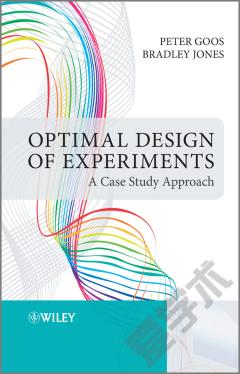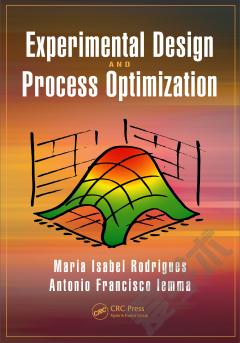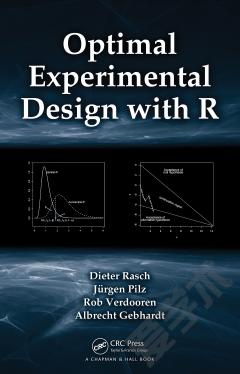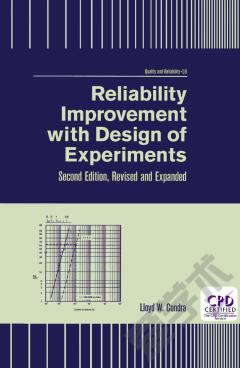Optimal Design of Experiments —— A Case Study Approach
----- 优化设计的实验:案例研究
Preface. Acknowledgments. 1 A simple comparative experiment. 1.1 Key concepts. 1.2 The setup of a comparative experiment. 1.3 Summary. 2 An optimal screening experiment. 2.1 Key concepts. 2.2 Case: an extraction experiment. 2.2.1 Problem and design. 2.2.2 Data analysis. 2.3 Peek into the black box. 2.3.1 Main-effects models. 2.3.2 Models with two-factor interaction effects. 2.3.3 Factor scaling. 2.3.4 Ordinary least squares estimation. 2.3.5 Significance tests and statistical power calculations. 2.3.6 Variance inflation. 2.3.7 Aliasing. 2.3.8 Optimal design. 2.3.9 Generating optimal experimental designs. 2.3.10 The extraction experiment revisited. 2.3.11 Principles of successful screening: sparsity, hierarchy, and heredity. 2.4 Background reading. 2.4.1 Screening. 2.4.2 Algorithms for finding optimal designs. 2.5 Summary. 3 Adding runs to a screening experiment. 3.1 Key concepts. 3.2 Case: an augmented extraction experiment. 3.2.1 Problem and design. 3.2.2 Data analysis. 3.3 Peek into the black box. 3.3.1 Optimal selection of a follow-up design. 3.3.2 Design construction algorithm. 3.3.3 Foldover designs. 3.4 Background reading. 3.5 Summary. 4 A response surface design with a categorical factor. 4.1 Key concepts. 4.2 Case: a robust and optimal process experiment. 4.2.1 Problem and design. 4.2.2 Data analysis. 4.3 Peek into the black box. 4.3.1 Quadratic effects. 4.3.2 Dummy variables for multilevel categorical factors. 4.3.3 Computing D-efficiencies. 4.3.4 Constructing Fraction of Design Space plots. 4.3.5 Calculating the average relative variance of prediction. 4.3.6 Computing I-efficiencies. 4.3.7 Ensuring the validity of inference based on ordinary least squares. 4.3.8 Design regions. 4.4 Background reading. 4.5 Summary. 5 A response surface design in an irregularly shaped design region. 5.1 Key concepts. 5.2 Case: the yield maximization experiment. 5.2.1 Problem and design. 5.2.2 Data analysis. 5.3 Peek into the black box. 5.3.1 Cubic factor effects. 5.3.2 Lack-of-fit test. 5.3.3 Incorporating factor constraints in the design construction algorithm. 5.4 Background reading. 5.5 Summary. 6 A "mixture" experiment with process variables. 6.1 Key concepts. 6.2 Case: the rolling mill experiment. 6.2.1 Problem and design. 6.2.2 Data analysis. 6.3 Peek into the black box. 6.3.1 The mixture constraint. 6.3.2 The effect of the mixture constraint on the model. 6.3.3 Commonly used models for data from mixture experiments. 6.3.4 Optimal designs for mixture experiments. 6.3.5 Design construction algorithms for mixture experiments. 6.4 Background reading. 6.5 Summary. 7 A response surface design in blocks. 7.1 Key concepts. 7.2 Case: the pastry dough experiment. 7.2.1 Problem and design. 7.2.2 Data analysis. 7.3 Peek into the black box. 7.3.1 Model. 7.3.2 Generalized least squares estimation. 7.3.3 Estimation of variance components. 7.3.4 Significance tests. 7.3.5 Optimal design of blocked experiments. 7.3.6 Orthogonal blocking. 7.3.7 Optimal versus orthogonal blocking. 7.4 Background reading. 7.5 Summary. 8 A screening experiment in blocks. 8.1 Key concepts. 8.2 Case: the stability improvement experiment. 8.2.1 Problem and design. 8.2.2 Afterthoughts about the design problem. 8.2.3 Data analysis. 8.3 Peek into the black box. 8.3.1 Models involving block effects. 8.3.2 Fixed block effects. 8.4 Background reading. 8.5 Summary. 9 Experimental design in the presence of covariates. 9.1 Key concepts. 9.2 Case: the polypropylene experiment. 9.2.1 Problem and design. 9.2.2 Data analysis. 9.3 Peek into the black box. 9.3.1 Covariates or concomitant variables. 9.3.2 Models and design criteria in the presence of covariates. 9.3.3 Designs robust to time trends. 9.3.4 Design construction algorithms. 9.3.5 To randomize or not to randomize. 9.3.6 Final thoughts. 9.4 Background reading. 9.5 Summary. 10 A split-plot design. 10.1 Key concepts. 10.2 Case: the wind tunnel experiment. 10.2.1 Problem and design. 10.2.2 Data analysis. 10.3 Peek into the black box. 10.3.1 Split-plot terminology. 10.3.2 Model. 10.3.3 Inference from a split-plot design. 10.3.4 Disguises of a split-plot design. 10.3.5 Required number of whole plots and runs. 10.3.6 Optimal design of split-plot experiments. 10.3.7 A design construction algorithm for optimal split-plot designs. 10.3.8 Difficulties when analyzing data from split-plot experiments. 10.4 Background reading. 10.5 Summary. 11 A two-way split-plot design. 11.1 Key concepts. 11.2 Case: the battery cell experiment. 11.2.1 Problem and design. 11.2.2 Data analysis. 11.3 Peek into the black box. 11.3.1 The two-way split-plot model. 11.3.2 Generalized least squares estimation. 11.3.3 Optimal design of two-way split-plot experiments. 11.3.4 A design construction algorithm for D-optimal two-way split-plot designs. 11.3.5 Extensions and related designs. 11.4 Background reading. 11.5 Summary. Bibliography. Index.
{{comment.content}}








 京公网安备 11010802027623号
京公网安备 11010802027623号